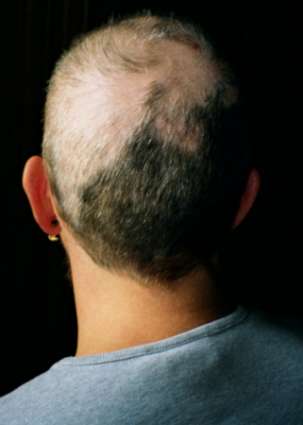Trichotillomania

A number sign (#) is used with this entry because of evidence that trichotillomania is caused by heterozygous mutation in the SLITRK1 gene (609678) on chromosome 13q31. One such patient has been reported.
DescriptionTrichotillomania (TTM) is a neuropsychiatric disorder characterized by chronic, repetitive, or compulsive hair pulling resulting in noticeable hair loss. The activity causes distress to the individual and often interferes with functioning. Affected individuals may develop physical complications and often have overlapping psychologic disorders, such as Tourette syndrome (GTS; 137580) or obsessive-compulsive disorder (OCD; 164230) (review by Novak et al., 2009).
Clinical FeaturesKerbeshian and Burd (1991) reported a 37-year-old woman with trichotillomania manifest as chronic pulling out of her eyebrows and eyelashes. She reported compulsive behavior, such as avoiding sidewalk cracks and counting the number of drips from a faucet, from age 6 years. She had experienced repeated sexual and physical abuse throughout her life. The episodes of trichotillomania were described as an irresistible impulse followed by a sense of tension release. She also had depression (608516). Treatment with clomipramine resulted in symptom improvement. Her sister and brother also had trichotillomania, but detailed history was not available.
InheritanceKerbeshian and Burd (1991) reported 3 affected sibs.
Novak et al. (2009) evaluated 33 female twin pairs and 1 male twin pair in which either 1 or both twins had trichotillomania. Significant differences in monozygotic and dizygotic concordance rates were observed for 3 of 5 diagnostic schemes: DSM-IV criteria (0.381 vs 0.00; p = 0.047), modified DSM criteria (0.391 vs 0.00; p = 0.021), and noncosmetic hair pulling (0.583 vs 0.200; p = 0.046), yielding heritability estimates between 0.76 to 0.78. The findings suggested that a significant proportion of trichotillomanic behavior can be accounted for by genetic factors. Analysis of concordance rates for possible similar phenotypes, including skin picking and hair manipulation, were not significantly different, suggesting that these are not alternate phenotypes of TTM.
Molecular GeneticsAbelson et al. (2005) identified a 1-bp deletion in the SLITRK1 gene (609678.0001) in a boy with Tourette syndrome and ADHD (143465). The mother, who had severe trichotillomania, also had the mutation, which was not found in 3,600 control chromosomes.
Animal ModelGreer and Capecchi (2002) noted that the behavior of Hoxb8 (142963)-null mice is not unlike that of humans suffering from the obsessive-compulsive spectrum disorder (OCD) trichotillomania. Consistent with this, they detected expression of Hoxb8 in regions of the CNS known as the 'OCD-circuit,' where OCD patients are thought to have abnormal metabolic activity. They hypothesized that trichotillomania may arise from a misregulation of an innate autogrooming behavior and presented Hoxb8-mutant mice as a model of OCD-like phenotypes.
Welch et al. (2007) generated Sapap3 (DLGAP3;611413)-deficient mice and found that they had increased anxiety and compulsive grooming behavior leading to facial hair loss (e.g., trichotillomania) and skin lesions. Both behaviors were alleviated by a selective serotonin reuptake inhibitor. Electrophysiologic, structural, and biochemical studies of Sapap3-mutant mice revealed defects in corticostriatal synapses.